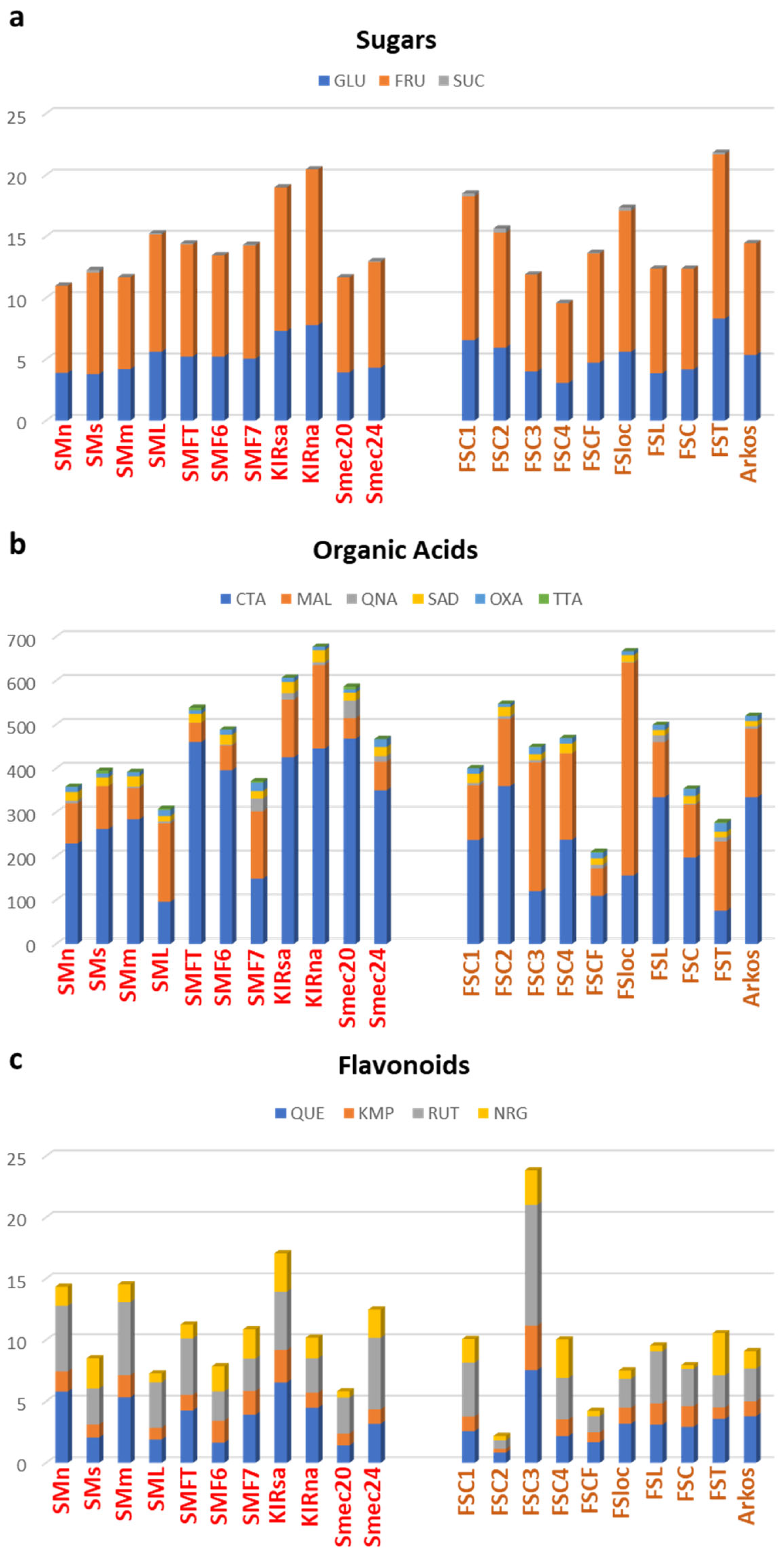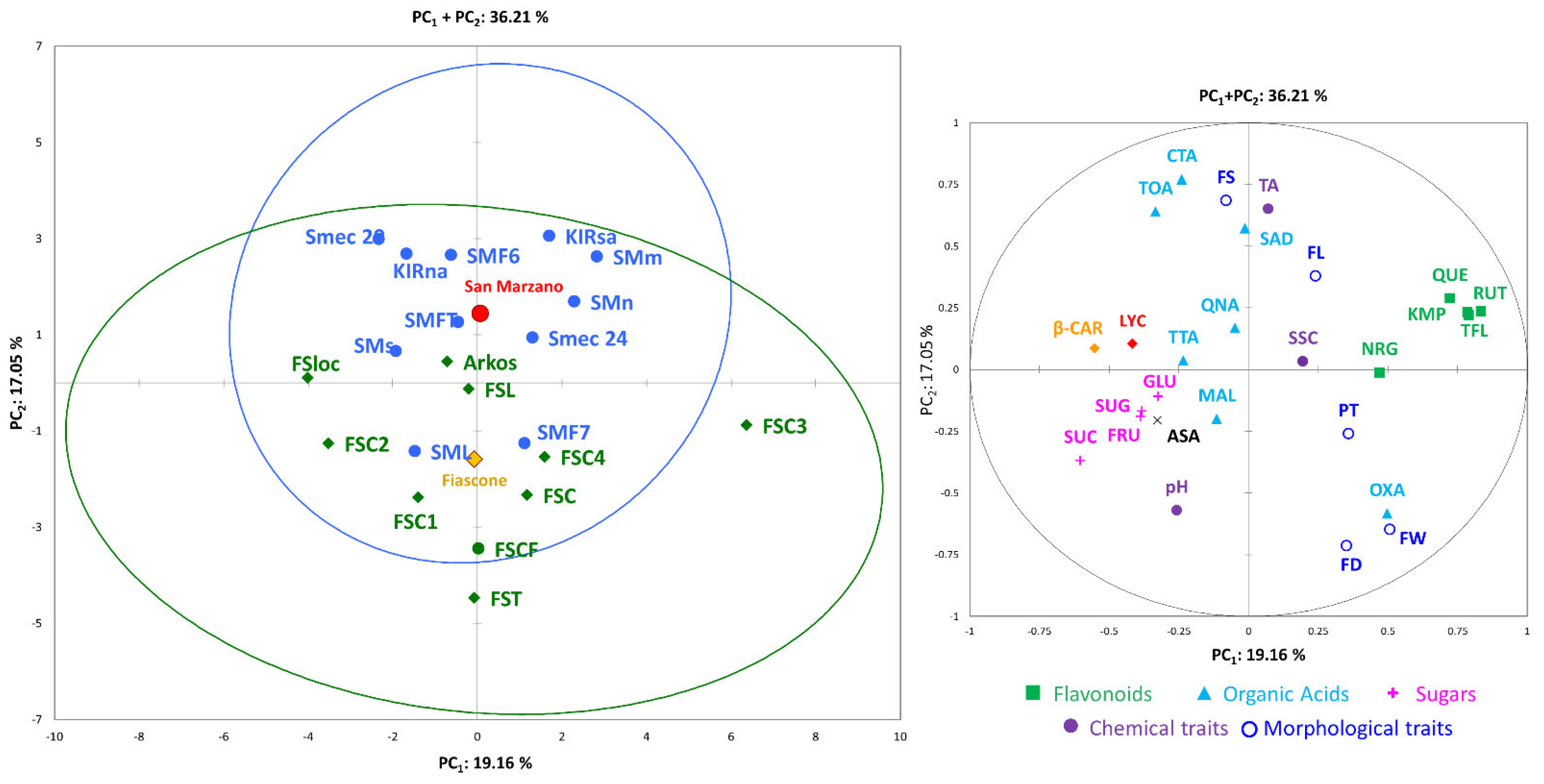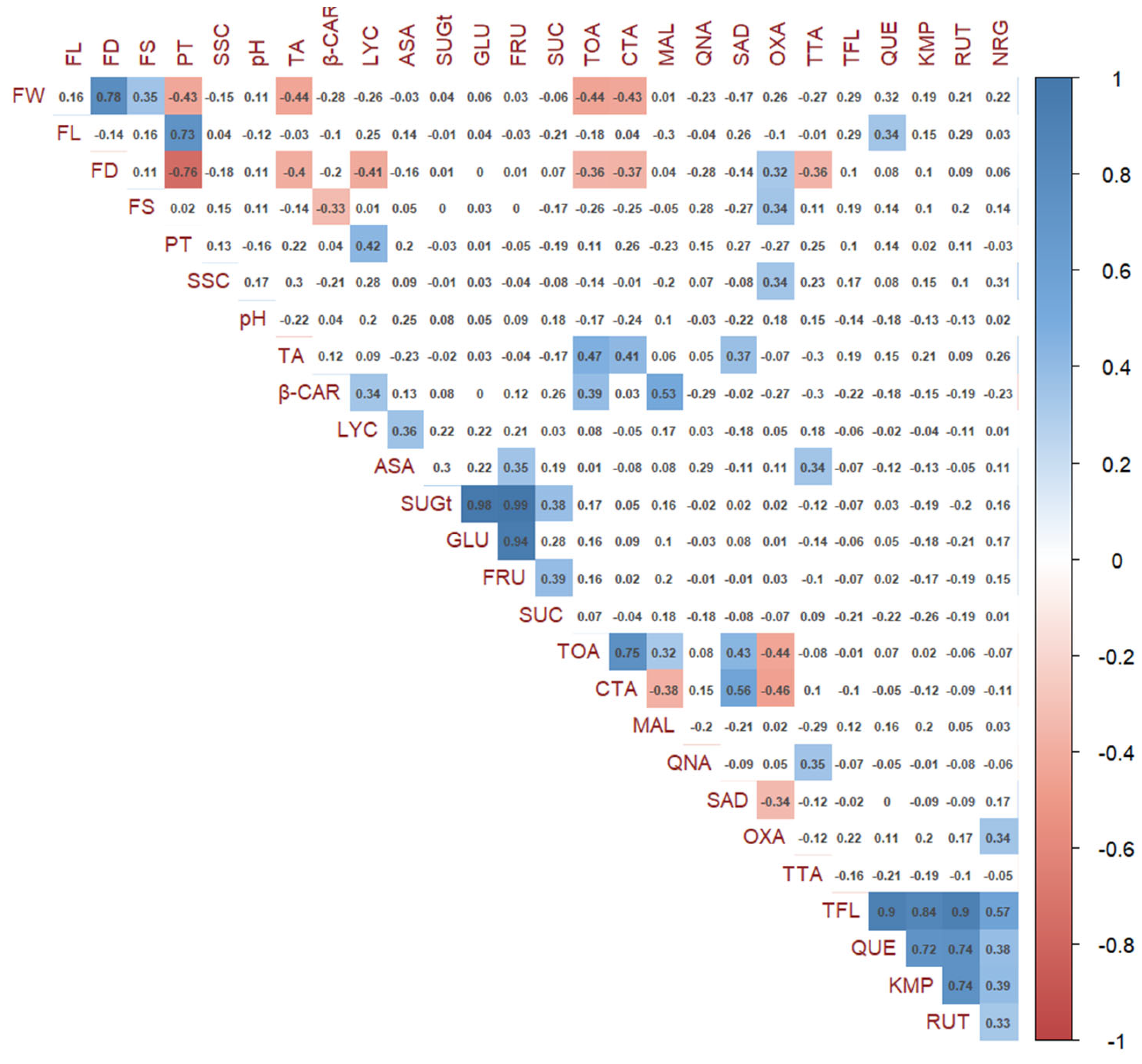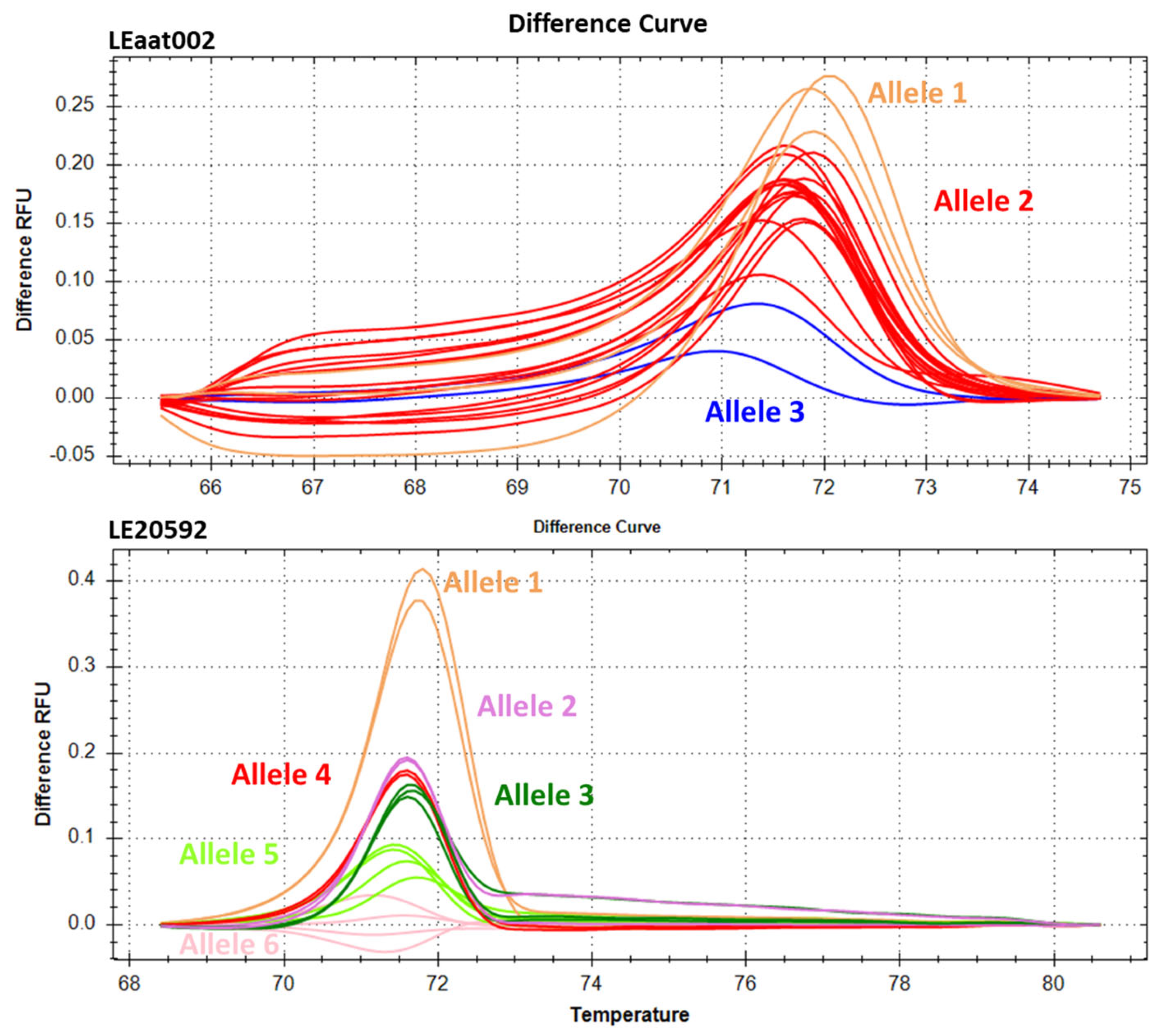Biochemical Characterisation and Genetic Structure Provide Insight into the Diversity of the Mediterranean Tomato Ancient Varieties ‘San Marzano’ and ‘Re Fiascone’: New Resources for Breeding
Abstract
:1. Introduction
2. Materials and Methods
2.1. Plant Material
2.2. Fruit Traits and Chemical Assessment
2.3. Biochemical Evaluation
2.3.1. Sugars
2.3.2. Ascorbic Acid
2.3.3. Organic Acids
2.3.4. Flavonoids
2.3.5. Carotenoids
2.4. DNA Isolation and Capillary Microsatellite Analysis
2.5. High-Resolution Melting Analysis
2.6. Phenotypic Data Analysis
2.7. Genetics Data Analysis
3. Results
3.1. Phenotypic Variation of ‘San Marzano’ and ‘Re Fiascone’ Groups
3.2. Morphological and Chemical Traits Performances
3.3. Bioactive Compounds
3.4. Multivariate Analysis and Correlations between Traits
3.5. Genetic Diversity
4. Discussion
5. Conclusions
Supplementary Materials
Author Contributions
Funding
Conflicts of Interest
References
- Grandillo, S.; Chetelat, R.; Knapp, S.; Spooner, D.; Peralta, I.; Cammareri, M.; Ercolano, M.R. Solanum sect. Lycopersicon. In Wild Crop Relatives: Genomic and Breeding Resources; Springer: Berlin/Heidelberg, Germany, 2011; pp. 129–215. [Google Scholar]
- Bauchet, G.; Causse, M. Genetic diversity in tomato (Solanum lycopersicum) and its wild relatives. In Genetic Diversity in Plants; Caliskan, M., Ed.; InTech: Shanghai, China, 2012; pp. 134–162. [Google Scholar]
- FAOSTAT. 2019. Available online: http://www.fao.org/faostat/en/#home (accessed on 15 November 2021).
- Sacco, A.; Cammareri, M.; Vitiello, A.; Palombieri, S.; Riccardi, R.; Spigno, P.; Grandillo, S. Italian traditional tomato varieties: A focus on the campania region. In Proceedings of the I Congrés de la Tomaca Valenciana: La Tomaca Valenciana d’El Perelló, El Perelló, Spain, 17 May 2017; pp. 179–193. [Google Scholar] [CrossRef]
- Terribile, F.; Basile, A.; De Mascellis, R.; Iamarino, M.; Magliulo, P.; Pepe, S.; Vingiani, S. Landslide processes and Andosols: The case study of the Campania region, Italy. In Soils of Volcanic Regions in Europe; Arnalds, Ó., Óskarsson, H., Bartoli, F., Buurman, P., Stoops, G., García-Rodeja, E., Eds.; Springer: Berlin/Heidelberg, Germany, 2007. [Google Scholar]
- Thakur, B.R.; Singh, R.K.; Nelson, P.E. Quality attributes of processed tomato products: A review. Food Rev. Int. 1996, 12, 375–401. [Google Scholar] [CrossRef]
- Casals, J.; Pascual, L.; Canizares, J.; Cebolla-Cornejo, J.; Casanas, F.; Nuez, F. The risks of success in quality vegetable markets: Possible genetic erosion in Marmande tomatoes (Solanum lycopersicum L.) and consumer dissatisfaction. Sci. Hortic. 2011, 130, 78–84. [Google Scholar] [CrossRef]
- Corrado, G.; Caramante, M.; Piffanelli, P.; Rao, R. Genetic diversity in Italian tomato landraces: Implications for the development of a core collection. Sci. Hortic. 2014, 168, 138–144. [Google Scholar] [CrossRef]
- King Umberto Tomato. 2021. Available online: https://www.refiascone.it/en/king-umberto-tomato/ (accessed on 15 November 2021).
- Acarbio. Available online: https://www.acarbio.org/ (accessed on 15 November 2021).
- Caramante, M.; Rao, R.; Monti, L.M.; Corrado, G. Discrimination of San Marzano accessions: A comparison of minisatellite, CAPS and SSR markers in relation to morphological traits. Sci. Hortic. 2009, 120, 560–564. [Google Scholar] [CrossRef]
- Cebolla-Cornejo, J.; Soler, S.; Nuez, F. Genetic erosion of traditional varieties of vegetable crops in Europe: Tomato cultivation in Valencia (Spain) as a case Study. Int. J. Plant Prod. 2007, 1, 113–128. [Google Scholar]
- Smith, P.; Gregory, P.J. Climate change and sustainable food production. Proc. Nutr. Soc. 2013, 72, 21–28. [Google Scholar] [CrossRef] [PubMed] [Green Version]
- Meybeck, A.; Gitz, V. Sustainable diets within sustainable food systems. Proc. Nutr. Soc. USA 2017, 76, 1–11. [Google Scholar] [CrossRef] [Green Version]
- Ali, M.Y.; Sina, A.A.I.; Khandker, S.S.; Neesa, L.; Tanvir, E.M.; Kabir, A.; Gan, S.H. Nutritional Composition and Bioactive Compounds in Tomatoes and Their Impact on Human Health and Disease: A Review. Foods 2021, 10, 45. [Google Scholar] [CrossRef]
- Agius, C.; von Tucher, S.; Poppenberger, B.; Rozhon, W. Quantification of sugars and organic acids in tomato fruits. MethodsX 2018, 5, 2537–2550. [Google Scholar] [CrossRef]
- De Vos, R.C.; Moco, S.; Lommen, A.; Keurentjes, J.J.; Bino, R.J.; Hall, R.D. Untargeted large-scale plant metabolomics using liquid chromatography coupled to mass spectrometry. Nat. Protoc. 2007, 2, 778–791. [Google Scholar] [CrossRef]
- Ishida, B.K.; Ma, J.; Chan, B. A simple, rapid method for HPLC analysis of lycopene isomers. Phytochem. Anal. 2001, 12, 194–198. [Google Scholar] [CrossRef]
- Bae, J.-H.; Han, Y.; Jeong, H.J.; Kwon, J.-K.; Chae, Y.; Choi, H.S.; Kang, B.-C. Development of a SNP marker set for tomato cultivar identification. Korea J. Hortic. Sci. Technol. 2010, 28, 627–637. [Google Scholar]
- He, C.; Poysa, V.; Yu, K. Development and characterization of simple sequence repeat (SSR) markers and their use in determining relationships among Lycopersicon esculentum cultivars. Theor. Appl. Genet. 2003, 106, 363–373. [Google Scholar] [CrossRef] [PubMed]
- R Core Team. The R Project for Statistical Computing 2020. Available online: https://www.R-project.org/ (accessed on 15 November 2021).
- Pritchard, J.K.; Stephens, M.; Donnelly, P. Inference of population structure using multilocus genotype data. Genetics 2000, 155, 945–959. [Google Scholar] [CrossRef] [PubMed]
- Structure Harverster. Available online: http://taylor0.biology.ucla.edu/structureHarvester/ (accessed on 15 November 2021).
- Kumar, S.; Stecher, G.; Li, M.; Knyaz, C.; Tamura, K. MEGA X: Molecular evolutionary genetics analysis across computing platforms. Mol. Biol. Evol. 2018, 35, 1547–1549. [Google Scholar] [CrossRef]
- Moco, S.; Bino, R.J.; Vorst, O.; Verhoeven, H.A.; de Groot, J.; van Beek, T.A.; Vervoort, J.; de Vos, C.H.R. A liquid chromatography-mass spectrometry-based metabolome database for tomato. Plant Physiol. 2006, 141, 1205–1218. [Google Scholar] [CrossRef] [Green Version]
- Gómez-Romero, M.; Segura-Carretero, A.; Fernández-Gutiérrez, A. Metabolite profiling and quantification of phenolic compounds in metanol extracts of tomato fruit. Phytochemisty 2010, 71, 1848–1864. [Google Scholar] [CrossRef]
- Slimestad, R.; Fossen, T.; Verheul, M.J. The flavonoids of tomatoes. J. Agric. Food Chem. 2008, 56, 2436–2441. [Google Scholar] [CrossRef]
- Khoury, C.K.; Brush, S.; Costich, D.E.; Curry, H.; de Haan, S.; Engels, J.M.M.; Guarino, L.; Hoban, S.; Mercer, K.L.; Miller, A.J.; et al. Crop genetic erosion: Understanding and responding to loss of crop diversity. New Phytol. 2022, 233, 84–118. [Google Scholar] [CrossRef]
- Lanz, B.; Dietz, S.; Swanson, T.M. The Expansion of Modern Agriculture and Global Biodiversity Decline. Ecol. Econ. 2018, 144, 260–277. [Google Scholar] [CrossRef]
- Fullana-Pericàs, M.; Conesa, M.; Douthe, C.; El Aou-ouad, H.; Ribas-Carbó, M.; Galmés, J. Tomato landraces as a source to minimize yield losses and improve fruit quality under water deficit conditions. Agric. Water Manag. 2019, 223, 105722. [Google Scholar] [CrossRef]
- Lopes, M.S.; El-Basyoni, I.; Baenziger, P.S.; Singh, S.; Royo, C.; Ozbek, K.; Aktas, H.; Ozer, E.; Ozdemir, F.; Manickavelu, A. Exploiting genetic diversity from landraces in wheat breeding for adaptation to climate change. J. Exp. Bot. 2015, 66, 3477–3486. [Google Scholar] [CrossRef] [PubMed]
- Khare, S.; Singh, N.B.; Singh, A.; Hussain, I.; Niharika, K.; Yadav, V.; Bano, C.; Yadav, R.K.; Amist, N. Plant secondary metabolites synthesis and their regulations under biotic and abiotic constraints. J. Plant Biol. 2020, 63, 203–216. [Google Scholar] [CrossRef]
- Boziné-Pullai, K.; Csambalik, L.; Drexler, D.; Reiter, D.; Tóth, F.; Tóthné Bogdányi, F.; Ladányi, M. Tomato Landraces Are Competitive with Commercial Varieties in Terms of Tolerance to Plant Pathogens—A Case Study of Hungarian Gene Bank Accessions on Organic Farms. Diversity 2021, 13, 195. [Google Scholar] [CrossRef]
- Frusciante, L.; Carli, P.; Ercolano, M.R.; Pernice, R.; Di Matteo, A.; Fogliano, V.; Pellegrini, N. Antioxidant nutritional quality of tomato. Mol. Nutr. Food Res. 2007, 51, 609–617. [Google Scholar] [CrossRef] [PubMed]
- Lázaro, A. Tomato landraces: An analysis of diversity and preferences. Plant Genet. Resour. 2018, 16, 315–324. [Google Scholar] [CrossRef]
- Lenucci, M.S.; Cadinu, D.; Taurino, M.; Piro, G.; Dalessandro, G. Antioxidant composition in cherry and high-pigment tomato cultivars. J. Agric. Food Chem. 2006, 54, 2606–2613. [Google Scholar] [CrossRef]
- Nour, V.; Trandafir, I.; Ionica, E.M. Antioxidant compounds, mineral content and antioxidant activity of several tomato cultivars grown in southwestern Romania. Not. Bot. Horti Agrobot. 2013, 41, 136–142. [Google Scholar] [CrossRef] [Green Version]
- Ilahy, R.; Hdider, C.; Lenucci, M.S.; Tlili, I.; Dalessandr, G. Phytochemical composition and antioxidant activity of high lycopene tomato (Solanum lycopersicum L.) cultivars grown in Southern Italy. Sci. Hortic. 2011, 127, 255–261. [Google Scholar] [CrossRef]
- García-Valverde, V.; Navarro-González, I.; García-Alonso, J.; Periago, M.J. Antioxidant bioactive compounds in selected industrial processing and fresh consumption tomato cultivars. J. Food Bioprocess. Technol. 2013, 6, 391–402. [Google Scholar] [CrossRef]
- Leonardi, C.; Ambrosino, P.; Esposito, F.; Fogliano, V. Antioxidative activity and carotenoid and tomatine contents in different typologies of fresh consumption tomatoes. J. Agric. Food Chem. 2000, 48, 4723–4727. [Google Scholar] [CrossRef]
- Rao, A.V.; Agarwal, S. Bioavailability and in vivo antioxidant properties of lycopene from tomato products and their possible role in the prevention of cancer. Nutr. Cancer 1998, 31, 199–203. [Google Scholar] [CrossRef] [PubMed]
- FDA. Guidance for Industry: A Food Labeling Guide. Available online: https://www.fda.gov/food/new-nutrition-facts-label/daily-value-new-nutrition-and-supplement-facts-labels (accessed on 20 December 2021).
- Vinson, A.J.; Hao, Y.; Su, X.; Zubik, L. Phenol antioxidant quantity and quality in foods: Vegetables. J. Agric. Food Chem. 1993, 46, 3630–3634. [Google Scholar] [CrossRef]
- Crozier, A.; Lean, M.E.J.; Mc Donald, M.S.; Black, C. Quantitative analysis of the flavonoid content of commercial tomatoes, onions, lettuce and celery. J. Agric. Food Chem. 1997, 45, 590–595. [Google Scholar] [CrossRef]
- Cebolla-Cornejo, J.; Roselló, S.; Valcárcel, M.; Serrano, E.; Beltrán, J.; Nuez, F. Evaluation of genotype and environment effects on taste and aroma flavor components of spanish fresh tomato varieties. J. Agric. Food Chem. 2011, 59, 2440–2450. [Google Scholar] [CrossRef]
- Loiudice, R.; Impembo, M.; Laratta, B.; Villari, G.; Voi, A.L.; Siviero, P.; Castaldo, D. Composition of San Marzano tomato varieties. Food Chem. 1995, 53, 81–89. [Google Scholar] [CrossRef]
- Suarez, M.; Rodriguez, E.; Romero, C. Analysis of organic acid content in cultivars of tomato harvested in Tenerife. Eur. Food Res. Technol. 2008, 226, 423–435. [Google Scholar] [CrossRef]
- Ganopoulos, I.; Argiriou, A.; Tsaftaris, A. Microsatellite high resolution melting (SSR-HRM) analysis for authenticity testing of protected designation of origin (PDO) sweet cherry products. Food Control 2011, 22, 532–541. [Google Scholar] [CrossRef]
- Esposito, S.; Cardi, T.; Campanelli, G.; Sestili, S.; Díez, M.J.; Soler, S.; Prohens, J.; Tripodi, P. ddRAD sequencing-based genotyping for population structure analysis in cultivated tomato provides new insights into the genomic diversity of Mediterranean ‘da serbo’ type long shelf-life germplasm. Hortic. Res. 2020, 7, 1–14. [Google Scholar] [CrossRef]
- Fusco Girard, L.; Gravagnuolo, A.; De Rosa, F. The Multidimensional Benefits of Terraced Landscape Regeneration: An Economic Perspective and Beyond. In World Terraced Landscapes: History, Environment, Quality of Life; Varotto, M., Bonardi, L., Tarolli, P., Eds.; Springer International Publishing: Cham, Switzerland, 2019; pp. 273–293. ISBN 978-3-319-96815-5. [Google Scholar]







| Marker Name | Forward | Reverse | Annealing °T | Size (bp) Observed | Reference |
|---|---|---|---|---|---|
| TCI C-419 | TGAGCAACATAAATGCATGTATGGC | AGAACAACTGTAGTGGTTCCATCACC | 55 °C | 444 | [19] |
| LE aat002 | GCGAAGAAGATGAGTCTAGAGCATAG | CTCTCTCCCATGAGTTCTCCTCTTC | 53 °C | 102–105 | [20] |
| LE aat007 | CAACAGCATAGTGGAGGAGG | TACATTTCTCTCTCTCCCATGAG | 53 °C | 95–98 | [20] |
| LE20592 | CTGTTTACTTCAAGAAGGCTG | ACTTTAACTTTATTATTGCCACG | 53 °C | 161–167 | [20] |
| LE21085 | CATTTTATCATTTATTTGTGTCTTG | ACAAAAAAAGGTGACGATACA | 50 °C | 102–103 | [20] |
| LEta003 | GCTCTGTCCTTACAAATGATACCTCC | CAATGCTGGGACAGAAGATTTAATG | 53 °C | 103–108 | [20] |
| LEtat002 | ACGCTTGGCTGCCTCGGA | AACTTTATTATTGCCACGTAGTCATGA | 55 °C | 99–105 | [20] |
| LEct001 | TCCAATTTCAGTAAGGACCCCTC | CCGAAAACCTTTGCTACAGAGTAGA | 53 °C | 98–107 | [20] |
| LEctt001 | CCTCTCTTCACCTCTTTACAATTTCC | CACTGGTCATTAAGTCTACAGCC | 55 °C | 90–91 | [20] |
| LEta015 | ATATGCATGGACAAATCTTGAGGG | CTCGCGCATCAAATTAATGTATCAG | 55 °C | 101–111 | [20] |
| Multivariate Test (Factor ‘Cultivar Groups’) | Multivariate Test (Factor ‘Genotype’) | ||||||||||
|---|---|---|---|---|---|---|---|---|---|---|---|
| Effect | Test Statistic | Value | F | df Hypothesis | df Error | Sig. (p) | Value | F | df Hypothesis | df Error | Sig. (p) |
| Category | Wilks’s lambda | 0.06 | 20.02 | 26 | 36 | <0.001 | 0.00 | 8.81 | 520 | 353 | <0.001 |
| Trait | Acronyms | Rsquare | F Ratio | Prob > F | San Marzano | Re Fiascone | ||||
|---|---|---|---|---|---|---|---|---|---|---|
| Range | Mean | CV | Range | Mean | CV | |||||
| Morphological Fruit Traits | ||||||||||
| Fruit weight | FW | 0.18 | 13.78 | *** | 66.8–27.38 | 54.69 | 25.55 | 82.44–40.17 | 67.79 | 20.69 |
| Fruit length | FL | 0.36 | 34.08 | *** | 76.55–51.61 | 66.46 | 11.77 | 67.00–47.83 | 56.18 | 10.05 |
| Fruit width | FD | 0.41 | 43.07 | *** | 40.07–28.94 | 36.08 | 11.71 | 52.87–34.5 | 44.92 | 14.12 |
| Fruit shape | FS | 0.67 | 126.85 | *** | 2.24–1.56 | 1.86 | 12.07 | 1.52–1.01 | 1.26 | 16.09 |
| Pericarp thickness | PT | 0.01 | 0.16 | ns | 8.47–4.17 | 6.51 | 22.89 | 8.74–4.00 | 6.34 | 28.93 |
| Chemical Traits | ||||||||||
| Soluble solids | SSC | 0.13 | 9.27 | ** | 5.97–3.47 | 4.92 | 15.47 | 5.30–4.13 | 4.44 | 9.21 |
| pH | pH | 0.02 | 1.29 | ns | 4.81–3.22 | 4.16 | 14.68 | 4.61–4.12 | 4.29 | 4.07 |
| Total acidity | TA | 0.15 | 11.08 | ** | 0.62–0.34 | 0.45 | 19.53 | 0.49–0.32 | 0.38 | 16.56 |
| Metabolic traits | ||||||||||
| β-carotene | β-CAR | 0.05 | 3.24 | ns | 8.56–4.46 | 6.37 | 24.63 | 16.29–3.55 | 7.74 | 52.37 |
| Trans-lycopene | LYC | 0.05 | 3.34 | ns | 112.82–37.75 | 71.71 | 38.72 | 91.08–27.28 | 58.40 | 51.46 |
| Ascorbic Acid | ASA | 0.01 | 0.53 | ns | 21.91–10.17 | 16.04 | 30.14 | 22.48–11.44 | 15.20 | 28.58 |
| Sugars Total | SUGt | 0.00 | 0.25 | ns | 20.48–10.99 | 14.23 | 27.29 | 21.83–9.59 | 14.77 | 31.18 |
| Glucose | GLU | 0.00 | 0.01 | ns | 7.78–3.79 | 5.12 | 32.56 | 8.31–3.07 | 5.16 | 36.58 |
| Fructose | FRU | 0.01 | 0.48 | ns | 12.68–7.09 | 9.07 | 25.04 | 13.37–6.49 | 9.50 | 28.15 |
| Sucrose | SUC | 0.04 | 2.48 | ns | 0.22–0.06 | 0.05 | 178.95 | 0.35–0.01 | 0.11 | 180.08 |
| Total Organic Acids | TOA | 0.01 | 0.80 | ns | 677.36–308.24 | 471.71 | 28.15 | 678.13–209.97 | 440.57 | 32.65 |
| Citric Acid | CTA | 0.15 | 10.74 | ** | 467.7–95.9 | 323.94 | 43.38 | 359.57–75.43 | 217.09 | 53.18 |
| Malic Acid | MAL | 0.18 | 13.55 | *** | 190.13–43.83 | 102.34 | 54.40 | 484.17–63.00 | 187.52 | 63.73 |
| Quinic Acid | QNA | 0.06 | 3.98 | ns | 39.5–0.25 | 10.82 | 115.61 | 15.2–0.25 | 6.01 | 73.79 |
| Succinic Acid | SAD | 0.19 | 14.08 | *** | 27.27–12.09 | 20.64 | 23.29 | 22.47–11.27 | 16.19 | 28.44 |
| Oxalic Acid | OXA | 0.03 | 1.80 | ns | 18.8–7.10 | 11.51 | 36.69 | 19.44–6.98 | 13.01 | 35.82 |
| Tartaric Acid | TTA | 0.15 | 10.53 | ** | 6.67–0.08 | 2.46 | 112.64 | 2.47–0.09 | 0.75 | 109.02 |
| Total Flavonoids | TFL | 0.02 | 1.34 | ns | 16.99–5.81 | 10.92 | 36.26 | 23.84–2.20 | 9.50 | 59.58 |
| Total Quercetins | QUE | 0.02 | 1.30 | ns | 6.53–1.42 | 3.69 | 52.74 | 7.54–0.84 | 3.15 | 57.41 |
| Total Kaempferols | KMP | 0.00 | 0.11 | ns | 2.65–0.97 | 1.48 | 45.36 | 3.63–0.31 | 1.42 | 64.90 |
| Total Rutins | RUT | 0.02 | 1.09 | ns | 5.96–2.36 | 3.98 | 38.97 | 9.84–0.69 | 3.44 | 72.89 |
| Total Naringenins | NRG | 0.02 | 0.94 | ns | 3.14–0.52 | 1.77 | 49.38 | 3.43–0.31 | 1.50 | 84.87 |
| Marker Name | CE-SSR | HRM-SSR | ||||||||
|---|---|---|---|---|---|---|---|---|---|---|
| Alleles | PIC | RP | EMR | MI | Alleles | PIC | RP | EMR | MI | |
| TCI C-419 | 1 | 0.00 | 0.00 | 0.00 | 0.00 | 1 | 0.00 | 0.00 | 0.00 | 0.00 |
| LEaat002 | 4 | 0.50 | 0.98 | 5.00 | 2.00 | 5 | 0.32 | 0.40 | 5.00 | 1.60 |
| LEaat007 | 3 | 0.43 | 0.63 | 3.00 | 1.30 | 4 | 0.38 | 0.50 | 4.00 | 1.50 |
| LE20592 | 5 | 0.20 | 0.22 | 6.00 | 1.20 | 6 | 0.23 | 0.27 | 6.00 | 1.40 |
| LE21085 | 2 | 0.13 | 1.86 | 2.00 | 0.27 | 3 | 0.38 | 0.51 | 3.00 | 1.14 |
| LEta003 | 4 | 0.39 | 0.52 | 4.00 | 1.55 | 4 | 0.36 | 0.48 | 4.00 | 1.45 |
| LEtat002 | 4 | 0.44 | 0.64 | 4.00 | 1.74 | 3 | 0.44 | 0.67 | 3.00 | 1.33 |
| LEct001 | 3 | 0.42 | 0.60 | 3.00 | 1.26 | 4 | 0.38 | 0.50 | 4.00 | 1.50 |
| LEctt001 | 3 | 0.31 | 0.38 | 3.00 | 0.93 | 4 | 0.36 | 0.48 | 4.00 | 1.45 |
| LEta015 | 7 | 0.44 | 0.67 | 7.00 | 3.11 | 3 | 0.24 | 0.29 | 3.00 | 0.73 |
| Total | 36.00 | 3.26 | 6.51 | 37.00 | 13.36 | 37.00 | 3.10 | 4.08 | 36.00 | 12.11 |
| Mean | 3.60 | 0.33 | 0.65 | 3.70 | 1.34 | 3.70 | 0.31 | 0.41 | 3.60 | 1.21 |
Publisher’s Note: MDPI stays neutral with regard to jurisdictional claims in published maps and institutional affiliations. |
© 2021 by the authors. Licensee MDPI, Basel, Switzerland. This article is an open access article distributed under the terms and conditions of the Creative Commons Attribution (CC BY) license (https://creativecommons.org/licenses/by/4.0/).
Share and Cite
Tripodi, P.; Pepe, R.; Francese, G.; Rosaria, M.; Onofaro Sanajà, V.; Di Cesare, C.; Festa, G.; D’Alessandro, A.; Mennella, G. Biochemical Characterisation and Genetic Structure Provide Insight into the Diversity of the Mediterranean Tomato Ancient Varieties ‘San Marzano’ and ‘Re Fiascone’: New Resources for Breeding. Agronomy 2022, 12, 18. https://doi.org/10.3390/agronomy12010018
Tripodi P, Pepe R, Francese G, Rosaria M, Onofaro Sanajà V, Di Cesare C, Festa G, D’Alessandro A, Mennella G. Biochemical Characterisation and Genetic Structure Provide Insight into the Diversity of the Mediterranean Tomato Ancient Varieties ‘San Marzano’ and ‘Re Fiascone’: New Resources for Breeding. Agronomy. 2022; 12(1):18. https://doi.org/10.3390/agronomy12010018
Chicago/Turabian StyleTripodi, Pasquale, Rosa Pepe, Gianluca Francese, Macellaro Rosaria, Vincenzo Onofaro Sanajà, Carlo Di Cesare, Giovanna Festa, Antonietta D’Alessandro, and Giuseppe Mennella. 2022. "Biochemical Characterisation and Genetic Structure Provide Insight into the Diversity of the Mediterranean Tomato Ancient Varieties ‘San Marzano’ and ‘Re Fiascone’: New Resources for Breeding" Agronomy 12, no. 1: 18. https://doi.org/10.3390/agronomy12010018






